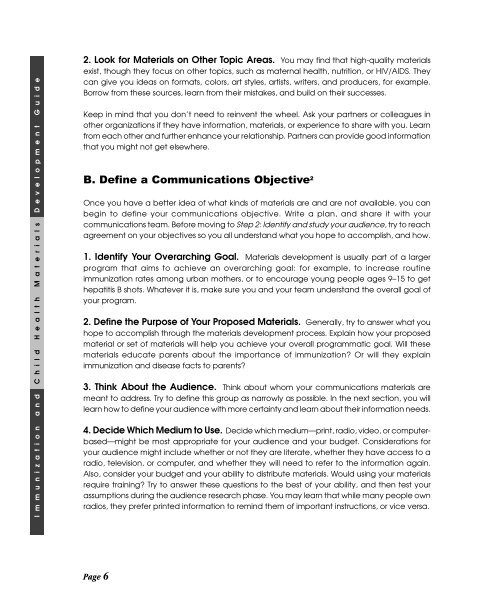Immunization and child health materials development guide pdf
Immunization and child health materials development guide pdf
Immunization and child health materials development guide pdf
Create successful ePaper yourself
Turn your PDF publications into a flip-book with our unique Google optimized e-Paper software.
2. Look for Materials on Other Topic Areas. You may find that high-quality <strong>materials</strong><br />
exist, though they focus on other topics, such as maternal <strong>health</strong>, nutrition, or HIV/AIDS. They<br />
can give you ideas on formats, colors, art styles, artists, writers, <strong>and</strong> producers, for example.<br />
Borrow from these sources, learn from their mistakes, <strong>and</strong> build on their successes.<br />
Keep in mind that you don’t need to reinvent the wheel. Ask your partners or colleagues in<br />
other organizations if they have information, <strong>materials</strong>, or experience to share with you. Learn<br />
from each other <strong>and</strong> further enhance your relationship. Partners can provide good information<br />
that you might not get elsewhere.<br />
B. Define a Communications Objective 2<br />
Once you have a better idea of what kinds of <strong>materials</strong> are <strong>and</strong> are not available, you can<br />
begin to define your communications objective. Write a plan, <strong>and</strong> share it with your<br />
communications team. Before moving to Step 2: Identify <strong>and</strong> study your audience, try to reach<br />
agreement on your objectives so you all underst<strong>and</strong> what you hope to accomplish, <strong>and</strong> how.<br />
1. Identify Your Overarching Goal. Materials <strong>development</strong> is usually part of a larger<br />
program that aims to achieve an overarching goal: for example, to increase routine<br />
immunization rates among urban mothers, or to encourage young people ages 9–15 to get<br />
hepatitis B shots. Whatever it is, make sure you <strong>and</strong> your team underst<strong>and</strong> the overall goal of<br />
your program.<br />
2. Define the Purpose of Your Proposed Materials. Generally, try to answer what you<br />
hope to accomplish through the <strong>materials</strong> <strong>development</strong> process. Explain how your proposed<br />
material or set of <strong>materials</strong> will help you achieve your overall programmatic goal. Will these<br />
<strong>materials</strong> educate parents about the importance of immunization? Or will they explain<br />
immunization <strong>and</strong> disease facts to parents?<br />
3. Think About the Audience. Think about whom your communications <strong>materials</strong> are<br />
meant to address. Try to define this group as narrowly as possible. In the next section, you will<br />
learn how to define your audience with more certainty <strong>and</strong> learn about their information needs.<br />
4. Decide Which Medium to Use. Decide which medium—print, radio, video, or computerbased—might<br />
be most appropriate for your audience <strong>and</strong> your budget. Considerations for<br />
your audience might include whether or not they are literate, whether they have access to a<br />
radio, television, or computer, <strong>and</strong> whether they will need to refer to the information again.<br />
Also, consider your budget <strong>and</strong> your ability to distribute <strong>materials</strong>. Would using your <strong>materials</strong><br />
require training? Try to answer these questions to the best of your ability, <strong>and</strong> then test your<br />
assumptions during the audience research phase. You may learn that while many people own<br />
radios, they prefer printed information to remind them of important instructions, or vice versa.<br />
Page 6

















